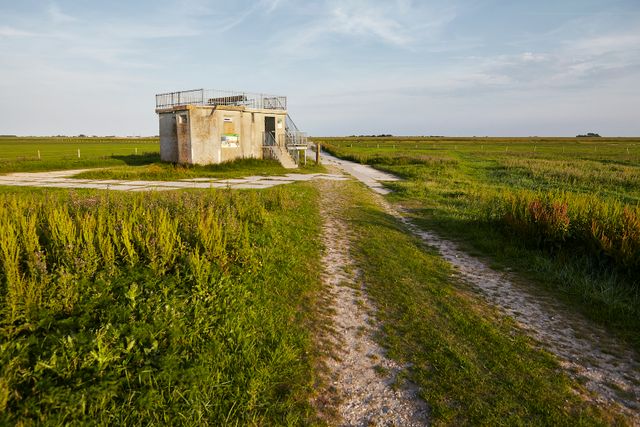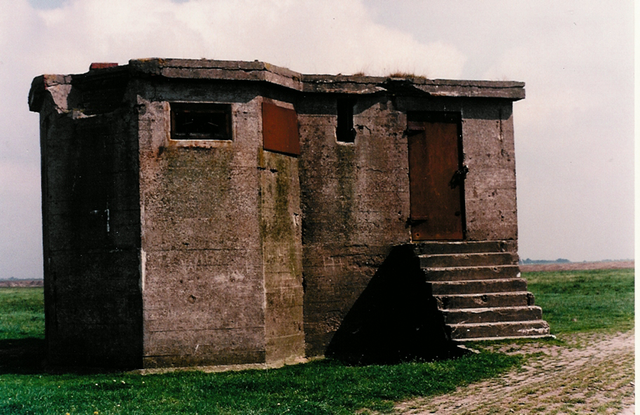Noarderleech Bunker and Training Base
Hallum
The famous Noarderleech bunker is situated near the coastal dike in Hallum. The training base for bombers that the Germans set up here was part of the military air transport command at the Leeuwarden air base.
Take a look
(The account that follows relates to the Noarderleech Route, which tells the story of the battle for the Wadden during the Second World War.)
On 13 August 1940, a hundred Germans with wheelbarrows arrived to build a training base for bombers. Livestock in the Noarderleech area were rounded up and grass was sold. Polhoeder Roeda, who was responsible for overseeing the area, told the Germans that the land was frequently flooded by storms but this did not deter them from their plans. The training base was part of the military air transport command at the Leeuwarden air base. It was named SF 10 Marrum, with ‘SF’ standing for Scheinflughafen or dummy airfield. The training base was completed on 17 August. In October, preparations were made to build a road to where the bunker now stands.
Construction of the bunker
In 1941, work started on the construction of the bunker. A contractor from Oude Bildtzijl by the name of Van Slooten helped build it. On 15 December 1941, while delivering cement, his son saw the bodies of the airmen who flew the Junkers planes lying on the ground. Just as in other bunkers of this kind, a system of mirrors installed near the semi-circular opening at the top of the bunker served as a 360-degree observation deck. The opening was later sealed up and the mirrors were removed.
After the war it was discovered that the bunker had been hit by bullets and grenades in several places. The damage caused by the impact was later restored by It Fryske Gea and is no longer visible.
The concrete walls of the observation post are 50 cm thick. Yet the roof is very thin for a bunker. The floor of the bunker is raised with concrete steps leading up to the door. The first record of a flight training exercise that involved shooting was on 6 January 1941. Before each training exercise, the polhoeder had to ensure that there were no livestock or people in the fields. He also had to arrange for the holes left by practice bombs and bombs jettisoned in an emergency to be filled.
A large red ‘N’ near the summer dike marked the spot where live bombs were to be dropped in an emergency. There was a target with a 500-metre radius. Two wooden frames resembling ships served as targets on which the planes could drop practice bombs.
These were made of concrete and contained glass vials filled with chlorosulfonic acid. So when a bomb hit the ground, it produced smoke that could be seen from the observation bunker so accuracy could be assessed. When ploughing to plant potatoes after the war, Polhoeder Hiddema unearthed several practice bombs, sometimes damaging the glass vials in the process.
Training base
The soldiers flying the planes also shot at targets on the marshland near the summer dike. A mark was made next to the bunker but it is not known what purpose it served. Three German planes crashed in the area outside of the dike during the training exercises. One of these planes, and its pilot, are still stuck in the ground. In 2016, a sign was placed next to the bunker with the story of the training base and the 21-year-old pilot Georg Wilhelm.
Emergency landing in Noarderleech
- Aircraft: Messerschmitt BF 109E-3
- Sunday 12 May 1940, Time 13:00 hours
- Serial number: , Registration:
- Unit: 6./(J)186
- Crew: unknown, unhurt
During the Battle of the Afsluitdijk, a Messerschmitt fighter plane was hit by Dutch anti-aircraft artillery. The pilot had to make an emergency landing near the Oude Dobbe on the summer polder in Noarderleech. He managed to flee from the plane on foot. He was taken in by the Roeda family. According to the daughter of the family, he was quite shaken by the incident, but after a cup of hot chocolate left for Leeuwarden with his comrades.
The Germans who came to salvage the plane stayed at the Roeda farm for a couple of days. There were seven of them: six crew members and a non-commissioned officer. The payment the family received for providing beds and lodging was 20 cents per day for crew members, 50 cents per day for non-commissioned officers and 30 cents for heating. In this instance, the soldiers received 15 litres of warm milk per day, for which Roeda charged the cost of a hot meal.
Plane crash in Noarderleech.
- Aircraft: Junkers Ju 88
- Monday 15 December 1941
- Serial number: 1279, Registration:
- Unit: 1./KG 506
- Crew:
NCO Emil Stürzel (27) Pilot KIA
NCO Otto Flohr (21) Radio Operator KIA
Senior Lieutenant Johann Klatte (27) Observer KIA
NCO Werner Schlegel (23) Gunner KIA
Crashed in Noarderleech while dropping practice bombs or shooting from the air during a practice flight.
Polhoeder Roeda witnessed the incident and described it as follows: ‘On 15 December 1941, a heavy German bomber crashed during a practice flight. The plane bounced off the ground, caught fire, travelled another 400 to 500 metres and then crashed into the ground. There were four dead. I was standing a mere 200 metres from where it happened. It was over in a flash. There were two decapitated corpses on the new road, the bodies mangled and broken. It was a dreadful sight to behold.’
The airmen were buried at the Noorderbegraafplaats cemetery in Leeuwarden. Later their remains were transferred to the German war cemetery near Ysselsteyn.
Plane crash in Marrum:
- Aircraft: Dornier Do 215 B5
- Friday 01 May 1942
- Serial number: 0041, Registration: RV+5N
- Unit: 5./NJG2 Leeuwarden
- Crew:
Senior Lieutenant R. Rausscher (21) Pilot
NCO Herbert Blumenthal (25) Radio Operator KIA
NCO Heinz Warbelow (25) Flight Engineer. KIA
During a practice flight near Marrum, a Dornier Do 215 BS crashed into the ground. Possibly in Noarderleech or on the marshlands of Noard-Fryslân Bûtendyks. In his annual report, Polhoeder Roeda noted: ‘On 1 May somewhat milder weather. Today, during a practice flight, another of the fighter planes crashed. There were two deaths.’
The two airmen who died were buried at the cemetery in Leeuwarden. Later their remains were transferred to the German war cemetery near Ysselsteyn.
Here you will find Noarderleech Bunker and Training Base
Zeedijk9074 TN Hallum Plan your route naar Noarderleech Bunker and Training Base
from your location




